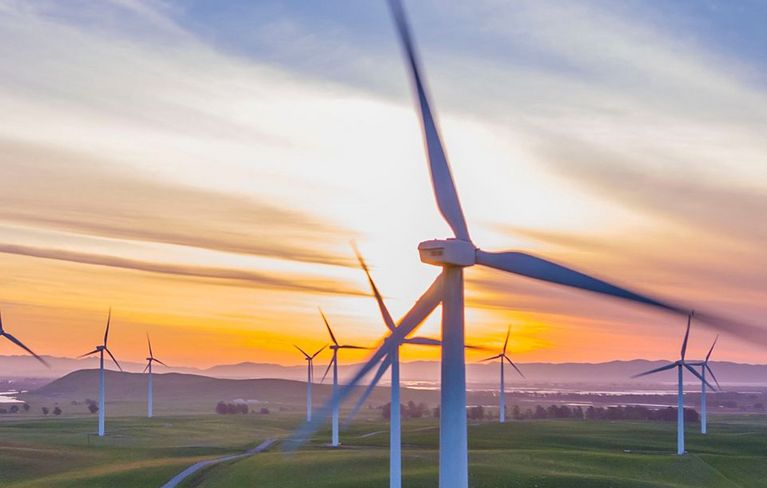
2. Helmholtz Sustainability Summit
2nd Helmholtz Sustainability Summit ‘People, research, energy: using resources efficiently’
Using energy, buildings and devices more sustainably: At the 2nd sustainability summit, the experts and employees of the Helmholtz Centres exchanged ideas on how to conserve resources.
For many, this was their first face-to-face conference since the start of the pandemic, so they were delighted to be able to share ideas in person again. At the German Electron Synchrotron (DESY) in Hamburg, experts and participants with an interest in sustainability discussed how to promote sustainable change at Helmholtz.
This time, the meeting focused on resource efficiency, and Helmholtz is thinking big. “Of course, we’re thinking about how we can advance our own transformation,” says Fabian Trinkel, a Helmholtz coordinator responsible for sustainability. “The focus is on ideas for climate protection measures at Helmholtz, but also on issues such as the sustainable use of buildings, resource-efficient procurement, innovative HR management and dealing with digitalisation as part of our organisational culture. We definitely want to discuss and drive sustainability forward across the board at the summit.” He was hosting the summit together with the Sustainability Forum Working Group. Some 65 employees travelled to Hamburg, while more than 500 people followed the livestream over the two-day event.
A plethora of creative ideas was presented over the course of the summit. Participants in the digital workshop suggested installing dashboards for computing power in the research centres. These programs would show how much carbon dioxide individual research groups are producing when using computationally intensive computer simulations for their studies. Power consumption in the data centres can be pinpointed with such precision that scientists could receive a kind of receipt after completing their research work: “Your simulation cost 500 kilograms of carbon dioxide,” for instance.
Such measures have the potential to significantly increase awareness of sustainable research and work, explains Trinkel, as they show users how many resources they use in their everyday activities, whether in daily research work or in administration. The Forschungszentrum Jülich (FZJ) is already integrating employees into this approach: in the Living Lab Energy Campus they can track the energy and heat consumption of the more than 200 buildings on campus in real time on dashboards via the intranet. This provides an incentive to behave more mindfully.
Generally speaking, however, the idea of conserving resources at Helmholtz must penetrate even more deeply into everyday work, as all participants at the summit agreed. “Scientific organisations not only have to research sustainability, they must also tackle the topic as pioneers,” said Helmholtz President Otmar D. Wiestler in his welcoming address.
The first outcomes of this commitment are already evident within the community. One example is a small area of woodland near Stuttgart, where the German Aerospace Center (DLR) operates the H2ORIZON project, a plant that produces hydrogen. DLR's Lampoldshausen site requires enormous quantities of this gas: the facility is one of the largest hydrogen users in Europe due to its engine tests. It intends to cover this enormous demand sustainably in the future by using the hydrogen that H2ORIZON produces from green electricity that comes from excess supply at a nearby wind farm. In this way, hydrogen becomes a sustainable resource and a wide range of possible uses can be tested in an actual laboratory.
Like in Lampoldshausen, many more flagship projects will be created at Helmholtz in the future, as the association is now proposing in a position paper. To that end, its scientists are testing innovative technologies to reduce carbon dioxide. If they are proven to be effective, other institutions could soon adopt them – inside the association and beyond.
To give one example, the Karlsruhe Institute of Technology (KIT) (link www.kit.edu/english/index.php) is testing various battery models and heating systems at the Energy Lab 2.0 on its North Campus. Sensors in the KIT office buildings also record central consumption data and electric cars whir across the campus. The project aims to run this campus on a carbon-neutral basis in the future.
The knowledge gained from this project will have an impact far beyond this location, as the scientists are planning to apply their experience on a massive scale, helping a city of 300,000 people switch to renewable energies from 2023. The instigators of the project also report on their future-forward project – the largest renewable energy research infrastructure in Europe – in the Sustainably active brochure, which was published to accompany the summit. It presents 18 projects in which Helmholtz promotes the efficient use of resources.
“For a successful, resource-efficient future, we need intensive exchange of ideas, and that’s just as true at Helmholtz,” says Trinkel. The sustainability summit marked another important step in this direction.
On both days of the event, Helmholtz employees unearthed real treasure in the workshops, which were dedicated to exciting topics. Thanks to social distancing, outdoor gathering and the necessary precautions, participants were also able to network in the evenings.
During the event, the sustainable development of the Helmholtz Association was promoted in five different workshops. Work took the form of a treasure hunt – participants were invited to “dig up treasure”. As part of groups, they worked on three areas, set out within the same space:
Quest 1: Clarifying the question, expert stimulus, discovery of first treasure
Quest 2: Finding treasure – working out detailed solutions
Quest 3: Summary and review of the results
The resulting treasures were presented to all participants at the end of the summit.